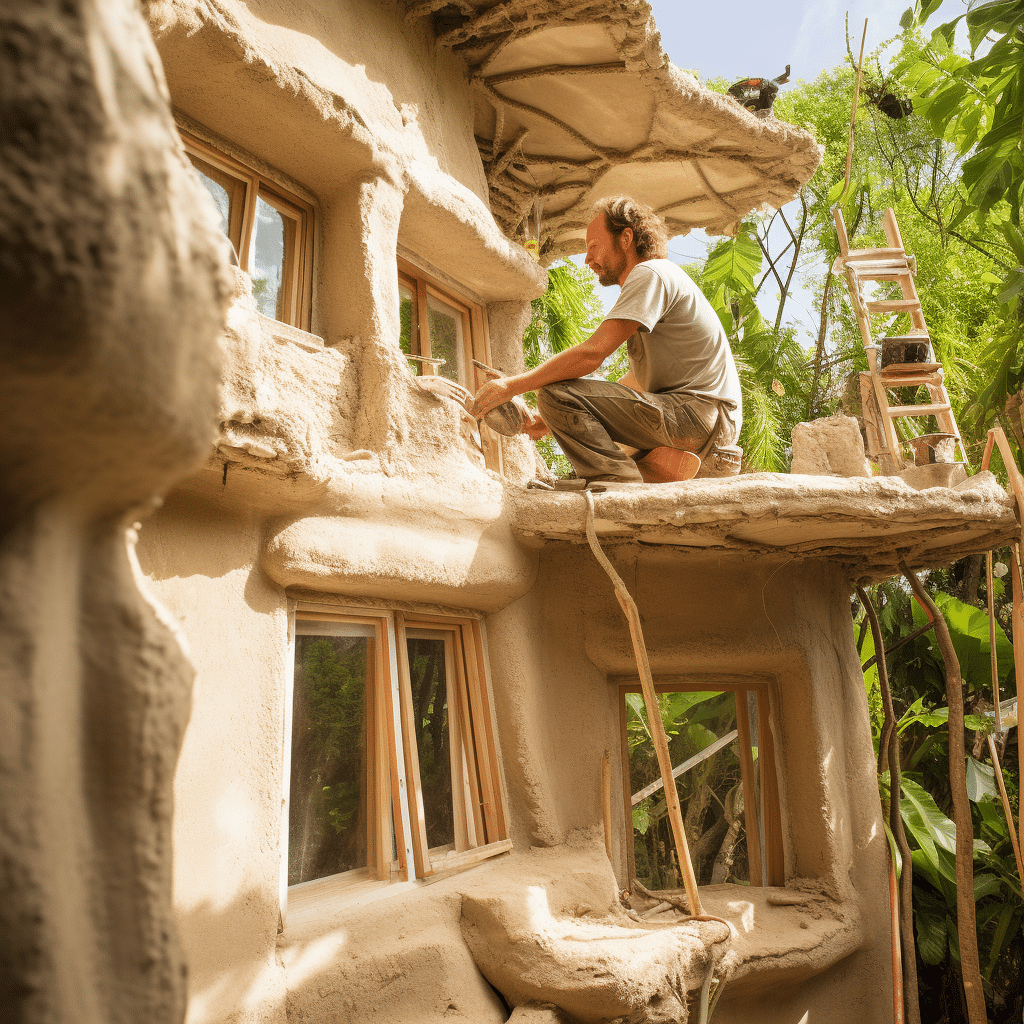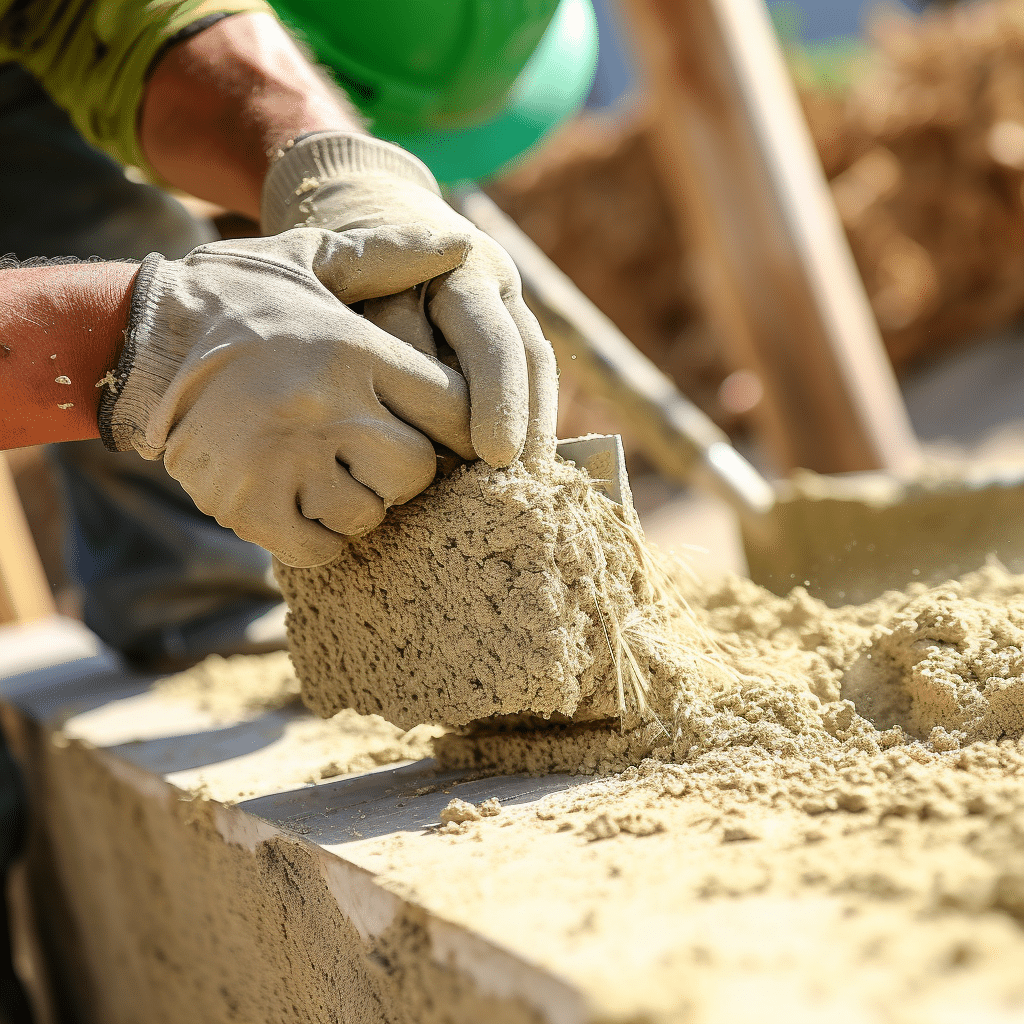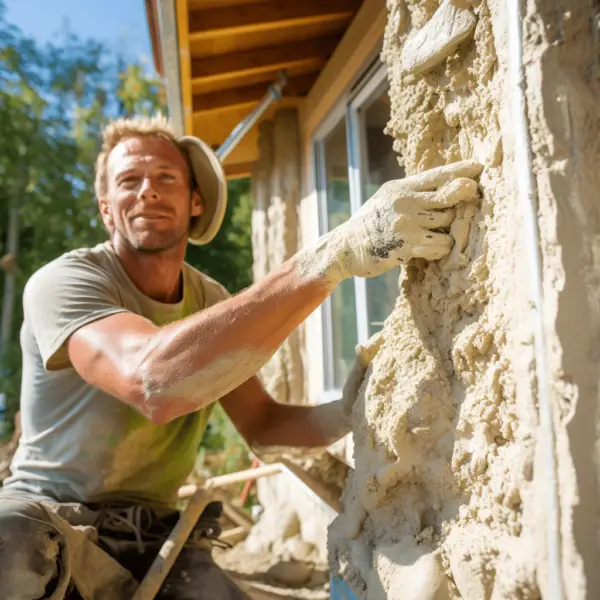Discovering the Potential of Hempcrete in Construction
Hempcrete in Sustainable Construction: Hempcrete reduces greenhouse gas emissions by being carbon-negative. We can fight climate change and build a sustainable future by using hempcrete in building. Hempcrete is environmentally friendly and thermally insulating. It regulates indoor temperatures for comfort and energy savings. Hempcrete is fire-resistant, making it safer for buildings. Chemical-free indoor conditions are guaranteed by its non-toxicity.
Hempcrete, an eco-friendly material derived from the versatile hemp plant, is revolutionizing the construction industry. With its sustainable properties and potential for innovative design, hempcrete is gaining recognition as a viable alternative to traditional building materials.
As a journalist specializing in construction, I am excited to explore the numerous benefits of hempcrete and its role in sustainable construction practices. From reducing carbon emissions to regulating indoor temperatures, hempcrete has the potential to transform the way we build.
Key Takeaways:
- Hempcrete is an eco-friendly material derived from the hemp plant.
- It offers numerous benefits for sustainable construction projects.
- Hempcrete has the ability to sequester carbon dioxide and reduce carbon emissions.
- It provides effective thermal insulation and regulates indoor temperatures.
- Hempcrete is gaining recognition as a viable alternative to traditional building materials.
The Environmental Benefits of Hempcrete

Hempcrete, a biocomposite made from hemp shiv and lime binder, offers several environmental benefits that make it an attractive choice for construction projects. One of the key advantages of hempcrete is its carbon-negative properties. It has the remarkable ability to sequester more carbon dioxide than it emits, making it a sustainable solution for reducing greenhouse gas emissions.
Furthermore, hempcrete is a fire-resistant material, providing an added layer of safety to buildings. It does not burn or release toxic fumes when exposed to flames, making it an excellent choice for fire-resistant construction. In addition, hempcrete is non-toxic and does not require the use of added chemicals. This means that it provides a healthier indoor environment, free from harmful substances.
“Hempcrete’s carbon-negative properties and fire-resistant nature make it an environmentally friendly and safe option for construction projects.”
Hempcrete’s eco-friendly attributes extend beyond its carbon-negative and fire-resistant properties. It is also a renewable and sustainable material. Hemp grows quickly and requires less space for cultivation compared to other crops, making it an environmentally friendly choice. Additionally, hempcrete is biodegradable, which means it has a minimal impact on the environment at the end of its life cycle.
Table: Environmental Benefits of Hempcrete
| Environmental Benefit | Description |
|---|---|
| Carbon-negative | Hempcrete sequesters more CO2 than it emits, making it a carbon-negative material. |
| Fire-resistant | Hempcrete does not burn or release toxic fumes when exposed to flames, enhancing building safety. |
| Non-toxic | As a natural material, hempcrete does not require the use of added chemicals, creating a healthier indoor environment. |
| Renewable and sustainable | Hemp grows quickly and requires less space for cultivation, making it an eco-friendly choice. |
| Biodegradable | Hempcrete breaks down naturally at the end of its life cycle, minimizing environmental impact. |
With its carbon-negative properties, fire resistance, non-toxic nature, and sustainability, hempcrete is proving to be a valuable material in the pursuit of eco-friendly and sustainable construction practices. As architects and builders continue to recognize its environmental benefits, we can expect to see more widespread adoption of hempcrete in the construction industry in the years to come.
The Thermal Properties of Hempcrete
Hempcrete is an extraordinary material that possesses exceptional thermal properties, making it a highly effective insulator. Its unique composition, consisting of hemp shiv and lime binder, contributes to its ability to regulate temperature fluctuations and create comfortable indoor environments.
One of the key advantages of hempcrete as a thermal insulator is its capacity to absorb and release moisture. During periods of high humidity, hempcrete readily absorbs moisture from the air, which helps to regulate the indoor climate and maintain a comfortable level of humidity. Conversely, when humidity levels drop, hempcrete releases the accumulated moisture, preventing the space from becoming excessively dry. This moisture regulation feature adds to the overall thermal stability of buildings constructed with hempcrete.
In addition to its moisture regulation capabilities, hempcrete also provides efficient insulation. Its composition creates a matrix of air pockets within the material, which act as natural insulation barriers. These air pockets trap heat and prevent its transfer, effectively reducing heat loss during colder periods and minimizing heat gain during warmer seasons. As a result, buildings constructed with hempcrete can achieve optimal energy efficiency, leading to reduced heating and cooling costs.
To showcase the thermal properties of hempcrete, the following table provides a comparison of its thermal conductivity (also known as lambda value) with other common building materials:
| Material | Thermal Conductivity (W/mK) |
|---|---|
| Hempcrete | 0.07 |
| Concrete | 1.0-1.7 |
| Brick | 0.6-1.0 |
| Wood | 0.13-0.4 |
As seen in the table, hempcrete has a significantly lower thermal conductivity compared to materials like concrete, brick, and wood. This means that it provides better insulation, allowing for greater temperature stability and energy efficiency in buildings.
Strength of Hempcrete vs. Concrete
Hempcrete is a sustainable alternative to traditional concrete in construction projects. While it may not have the same compressive strength as concrete, hempcrete offers a range of other benefits that make it a valuable material to consider.
Table: Comparing the Strength and Density of Hempcrete and Concrete
| Hempcrete | Concrete | |
|---|---|---|
| Compressive Strength | Approximately 1/20th of concrete | High compressive strength |
| Density | Only 15% of concrete | Higher density |
Hempcrete has 1/20 the compressive strength of concrete, as seen in the table. Despite its reduced density, hempcrete resists cracking under movement, making it suitable for earthquake-prone locations. Hempcrete’s low density makes it a good thermal insulator, regulating indoor climates and making them comfortable.
While hempcrete alone may not be load-bearing, it can be employed with a timber or steel structural structure. This combination maintains the building’s structural integrity while using hempcrete’s environmental and insulating characteristics. Building projects can benefit from hempcrete’s unique properties while preserving strength and durability by employing it strategically.
Case Studies: Successful Hempcrete Projects
When it comes to sustainable architecture, hempcrete has proven to be a game-changer. Several case studies highlight the successful use of hempcrete in construction, showcasing its potential as an eco-friendly building material. These projects demonstrate the versatility and effectiveness of hempcrete in creating energy-efficient and environmentally conscious structures.
The Triangle, UK
In the UK, The Triangle is a prime example of a successful hempcrete housing project. This innovative development features timber-framed units filled with cast hempcrete, harnessing the material’s excellent insulation properties. The Triangle showcases how hempcrete can be used to create sustainable and comfortable living spaces while reducing carbon emissions.
Case di Luce, Italy
In Italy, Case di Luce showcases the use of hemp in plaster and precast blocks. By incorporating hempcrete into the construction process, the project achieves both aesthetic and sustainable goals. These hempcrete elements contribute to the overall energy efficiency of the building and its ability to regulate indoor climate, creating a harmonious and environmentally friendly living environment.
Hempcrete Houses
These case studies highlight the potential of hempcrete houses in sustainable construction. By harnessing the natural properties of hemp and lime, these buildings offer excellent insulation, fire resistance, and moisture regulation. The use of hempcrete demonstrates a commitment to environmentally conscious design and construction practices.
| Case Study | Location | Hempcrete Application |
|---|---|---|
| The Triangle | UK | Timber-framed units filled with cast hempcrete |
| Case di Luce | Italy | Use of hemp in plaster and precast blocks |
These case studies demonstrate the successful integration of hempcrete into sustainable architecture projects. They showcase the material’s ability to create energy-efficient buildings while reducing the carbon footprint of the construction industry. As more architects and builders recognize the potential of hempcrete, we can expect to see an increase in the use of this innovative material in future construction projects.
Overcoming Challenges and Pushing Boundaries
Construction with hempcrete has presented various obstacles. Certification and agricultural licensing were major obstacles. The hempcrete regulatory structure was unclear at first, making it hard for architects and builders to use this eco-friendly material.
As the environment issue worsens, industry specialists are pushing limits and working with hempcrete. US building code approval for hempcrete insulation would give a framework for its use and encourage its acceptance.
Hempcrete’s potential goes beyond traditional building. Researchers are investigating its use in 3D printing for robust, cheap homes. This experimentation brings up new hempcrete uses and creative building methods.
Table: Challenges and Progress in Hempcrete Usage
| Challenges | Progress |
|---|---|
| Certification and licensing issues | Efforts to obtain building code certification |
| Limited understanding and awareness | Rising interest and research in hempcrete applications |
| Resistance from traditional construction industry | Increased recognition of hempcrete’s benefits |
| Limited availability and supply chain | Growth of companies supplying hempcrete products |
While there is still work to be done to fully integrate hempcrete into mainstream construction practices, the progress being made is promising. As more professionals in the industry recognize the benefits of hempcrete and embrace experimentation, we can expect to see its usage expand and become more accessible in the near future.
Hempcrete in Current and Future Projects
Current and future construction projects use hempcrete for its unique features and sustainability. Architectural and building firms are using hempcrete to construct eco-friendly and attractive structures. While hempcrete is not load-bearing, it can be mixed with other structural elements to create unique building designs and construction.
The Jonathan Tuckey Design-designed Hempcrete House is a modern expansion to a Victorian home. This project shows how hempcrete can add character and sustainability to a building. Another Surrey new-build home uses hempcrete and exposed timber beams for a distinctive appearance.
Hempcrete House Extension – Key Features
“The Hempcrete House extension seamlessly blends modern design with sustainable materials. By incorporating hempcrete into the structure, we were able to achieve both aesthetic and eco-friendly goals. The unique properties of hempcrete, such as its thermal insulation and fire-resistant qualities, make it an ideal choice for sustainable construction.”
While hempcrete is not suitable for load-bearing structures on its own, architects and builders are finding innovative ways to integrate hempcrete into their projects. By combining hempcrete with other structural materials, such as timber frames, they can achieve the desired aesthetic while benefiting from the sustainable properties of hempcrete. These projects highlight the growing interest and adoption of hempcrete in the construction industry as architects continue to explore its potential.
| Project Name | Location | Construction Type |
|---|---|---|
| Hempcrete House | London, UK | Contemporary extension to a Victorian villa, incorporating hempcrete |
| Surrey Residence | Surrey, UK | New-build home utilizing hempcrete alongside exposed timber beams |
The Future of Hempcrete in the United States
As the US sustainable construction movement grows, hempcrete’s potential as a building material is acknowledged. Working to integrate hempcrete into construction processes nationwide despite early building code and certification issues.
HempBlock USA and Hempitecture have become, giving builders the resources they need to use this eco-friendly solution. Texas A&M University academics are also investigating 3D printing for economical, durable housing.
The US Hemp Building Association has filed insulation for building code certification to promote its use. To ensure satisfies safety and quality criteria for general construction use, this step is essential.
Challenges and Opportunities
The legalization of industrial hemp in 47 states bodes well, but there are still obstacles. To overcome misconceptions about hemp as a construction material and navigate complex laws, hemp education and advocacy are needed.
However,it offers many benefits. Eco-friendly due to its fire resistance, carbon dioxide sequestration, and insulation, it is a sustainable building material. It could change US building and contribute to a greener future with more study and innovation.
| Pros | Cons |
|---|---|
| – Carbon-negative material | – Initial challenges with certification and building codes |
| – Fire-resistant | – Misconceptions about hemp as a construction material |
| – Excellent insulation properties |
The Promise of Hempcrete in Sustainable Construction

Hempcrete, a composite material made from hemp shiv and lime binder, holds significant promise in the field of sustainable construction. With its unique combination of eco-friendly properties, hempcrete is emerging as an innovative alternative to traditional building materials.
One of the key advantages of hempcrete is its ability to sequester carbon dioxide. As hemp grows, it absorbs CO2 from the atmosphere and locks it within its fibers. This makes hempcrete a carbon-negative material, contributing to the reduction of greenhouse gas emissions. By utilizing hempcrete in construction projects, we can actively combat climate change and create a more sustainable future.
In addition to its environmental benefits, hempcrete offers excellent thermal insulation properties. It helps regulate indoor temperatures, providing comfort and energy efficiency. Hempcrete also has fire-resistant properties, making it a safer choice for buildings. Its non-toxic nature ensures healthier indoor environments, free from harmful chemicals.
| Advantages of Hempcrete in Sustainable Construction |
|---|
| Sequesters carbon dioxide |
| Provides thermal insulation |
| Fire-resistant properties |
| Non-toxic and chemical-free |
While hempcrete may not have the same compressive strength as concrete, its low density makes it resistant to cracking under movement, which is especially beneficial in earthquake-prone areas. It can be used in conjunction with load-bearing structural systems of other materials to create safe and durable buildings.
As architects and researchers continue to explore the possibilities of hempcrete, we can expect to see more innovative designs and sustainable construction projects using this eco-friendly material in the years to come.
Conclusion
The potential of hempcrete in sustainable architecture and construction is undeniable. This eco-friendly material offers numerous benefits that make it an attractive alternative to traditional building materials. With its ability to sequester carbon dioxide, its fire-resistant and insulating properties, and its versatility in design, hempcrete is paving the way for a more sustainable future in construction. Architects and researchers are pushing the boundaries of hempcrete, experimenting with its various applications and exploring its potential in 3D printing and load-bearing structures.
Furthermore, the growing legal status of industrial hemp cultivation in the United States provides a promising future for hempcrete. Efforts are underway to obtain building code certification and develop a robust market for hempcrete products.
As more architects and builders recognize the potential of hempcrete, we can expect to see an increase in its use in sustainable architecture and construction projects. The future of hempcrete looks bright as it continues to contribute to a more sustainable and eco-friendly construction industry.
FAQ
What is hempcrete?
Hempcrete is a biocomposite material made from hemp shiv and lime binder, commonly used in construction for its environmental benefits and insulating properties.
What are the environmental benefits of hempcrete?
Hempcrete is carbon-negative, meaning it sequesters more carbon dioxide than it emits. It is also fire-resistant and non-toxic, making it a healthier and safer option for building construction.
How does hempcrete regulate indoor climates?
Hempcrete has the ability to absorb moisture during high humidity and release it when humidity levels drop. This helps regulate indoor climates and create comfortable interior environments.
How does the strength of hempcrete compare to concrete?
Hempcrete has a compressive strength of approximately 1/20th of concrete but a lower density. While it is not as strong as concrete, its low density makes it resistant to cracking under movement, making it suitable for areas prone to earthquakes.
Are there any successful case studies of hempcrete projects?
Yes, there are several successful case studies that showcase the use of hempcrete in sustainable architecture. Examples include housing projects like The Triangle in the UK and Case di Luce in Italy.
What challenges has hempcrete faced in the construction industry?
Hempcrete faced initial challenges with certification and agricultural licensing, hindering its widespread use. However, efforts are being made to obtain building code certification and overcome these obstacles.
How is hempcrete being used in current and future construction projects?
Hempcrete is being utilized in various construction projects, such as contemporary extensions to Victorian villas and new-build homes. While not load-bearing, it offers unique design possibilities when combined with other structural materials.
What is the future of hempcrete in the United States?
Efforts are being made to overcome legal and certification issues in the United States. Companies already supply hempcrete products, and researchers are exploring its potential for affordable and eco-friendly housing through 3D printing.
What is the promise of hempcrete in sustainable construction?
Hempcrete offers significant potential in sustainable construction due to its environmental benefits, thermal properties, and versatility in design. Architects and builders recognize its potential and continue to explore its possibilities.








